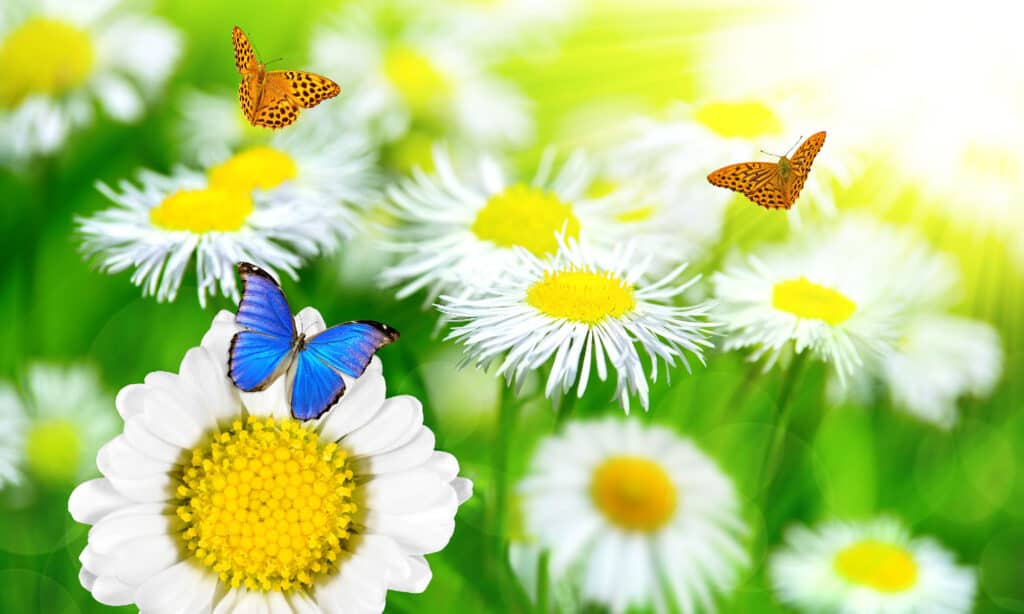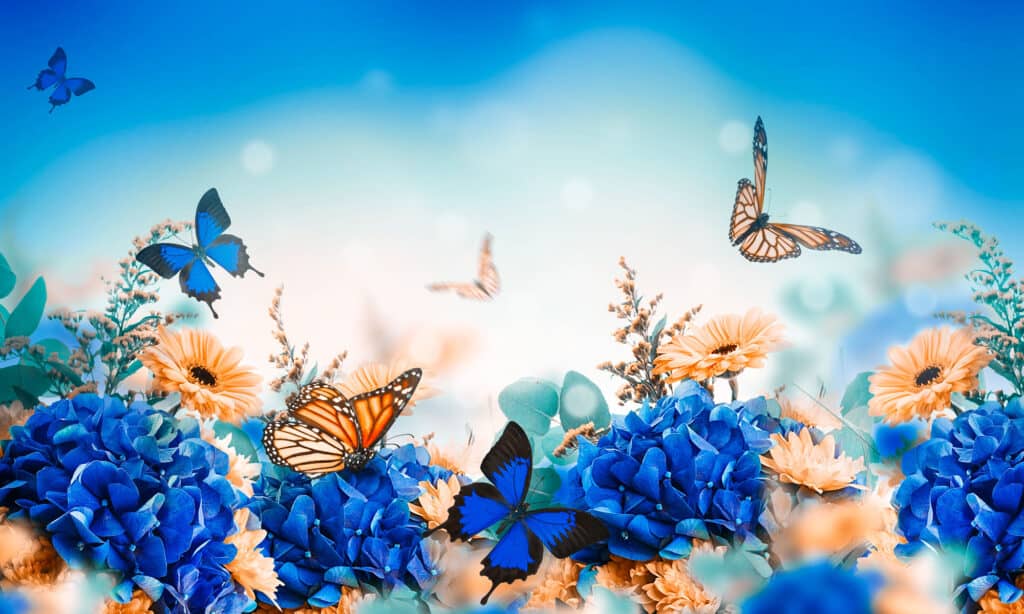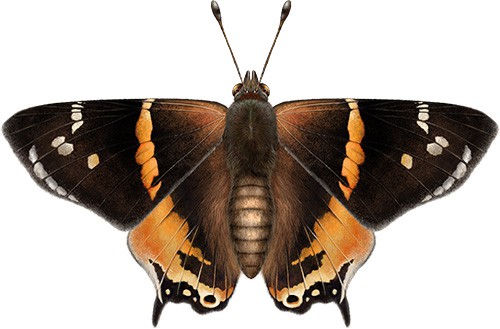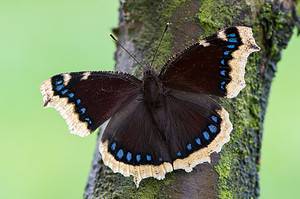On the perfect spring day, you might find yourself walking through a meadow of wildflowers or crouching in the dirt to sow the first seeds in your garden. While you’re enjoying the sunshine, you also might just see a beautiful animal fluttering by. Butterflies are magnificent creatures that have fascinated humans since the beginning of recorded history. They appear in poetry, artwork, and various other culturally significant forms around the world. But what were they like long before then? And what about species that used to live on this earth but no longer do? This article will explore how butterflies have evolved and become extinct over millions of years and then introduce 3 cool extinct butterflies!
What are Butterflies?

Butterflies are classified as insects.
©iStock.com/vencavolrab
Butterflies are insects belonging to the order Lepidoptera, which also includes moths. The name Lepidoptera is from the Greek words lepis- for “scale” and pteron for “wing”. Butterflies exist around the world except for Antarctica and many species also migrate over great distances. In fact, their migrations are so great that one individual might not live long enough to complete the entire trip.
As a result of this global distribution, butterflies are incredibly diverse. There are approximately 17,500 species of butterflies, including 750 species in the United States. They range in size from the 11-inch wingspan of Queen Alexandra’s Birdwing to the ½ inch wingspan of the western pygmy blue. Butterflies are also diverse in shape, pattern, and coloration. The oakleaf butterfly, for example, is cleverly known as the dead leaf butterfly. When it perches on a branch, the underside of its wings looks remarkably similar to a dead oak leaf and acts as camouflage. Many other species have vibrant colors that act as anything but camouflage!
Evolution
The fossil record of butterfly species is sparse, and many questions exist on the history of butterflies. The earliest identified butterfly species was alive approximately 56 million years ago during the Paleocene epoch. For perspective, the earliest member of the human lineage was alive around only 6 and 7 million years ago! Moths are the closest living relatives of butterflies, and a commonly accepted theory is that butterflies evolved from moths.
Cool Adaptations
Many different butterfly species have unique adaptations that help them survive and reproduce. The monarch butterfly, for example, deters predators by advertising with their bright wings that they are toxic. Advertising toxicity with bright colors is an example of aposematism. This is when an animal advertises to predators with odors, colors, sounds, or other signals that it would be unpleasant or harmful to attack. A different form of aposematism is the odor skunks produce to deter predators.
A second cool adaptation in many butterfly species is mimicry. One example of mimicry is the viceroy butterfly. The viceroy butterfly is not toxic to predators and is a favorite treat to many species of birds. It does, however, have a cool trick up its sleeve. The viceroy butterflies mimic monarch butterflies and cause predators into thinking they are the toxic monarchs themselves. The viceroys that look most like monarchs survive and reproduce more. Then over many generations, viceroy butterflies have evolved to look very similar to monarchs.
Why have Butterflies become Extinct?

Butterflies became extinct due to climate related extinction events.
©Seqoya/Shutterstock.com
Historically, butterfly species have been susceptible to climate-related extinction events. Recent studies suggest that rapid variance in climate sped up the demise of different butterfly species that were unable to adapt. This has been the case in many of the major mass extinction events including four of the “big five” mass extinctions, each of which led to the extinction of about 75% of the world’s species or more. The Permian-Triassic extinction event describes earth’s largest mass extinction which saw the demise of 90-96% of all plant and animal species. This event was the largest extinction of insects in history.
Declining Populations and Extinctions Today
Today, more than 450 species of butterflies are declining at rapid rates (around 2% a year) due to warmer autumns in the United States alone. Additionally, despite the western monarch population declining by 99.9%, in 2020 it was denied protection under the U.S endangered species act. It is recognized as endangered by the IUCN, though. More butterfly species around the world also face similar threats. A notable endangered species is the Queen Alexandra’s birdwing, the world’s largest butterfly, which is currently restricted to 40 square miles of coastal rainforest in Papua New Guinea.
After learning a little bit about their history and evolution, let’s meet 3 cool extinct butterflies!
1. Protocoeliades kristinseni: The Oldest Butterfly Fossil
The first extinct butterfly we will investigate is Protocoeliades kristinseni. This is the oldest fossil butterfly ever found dating to about 55 million years ago! It was discovered in what is now Denmark on the island of Fur. Only one fossil of this species has been found. It is unclear why this species became extinct due to limited evidence. Although P. kristinseni is extremely old, there are much older moth fossils that date to 190 million years ago! That would mean that ancient moths were alive to see the dinosaurs during the Jurassic Period.
Protocoeliades kristinseni likely lived from 55 to 48.6 million years ago. Since there is little fossil evidence of the species, scientists study its living relatives and compare them to the fossils. Protocoeliades kristinseni is closely related to the “awls”, a living type of skipper butterfly of the genus Hasora.
2. Xerces blue (Glaucopsyche xerces): A Recent Extinction

Xerces blue became extinct due to urban development.
©Brianwray26 / CC BY-SA 4.0 – License
The second extinct butterfly we will meet is the Xerces blue. The Xerces blue butterfly made headlines as being the first American species of butterfly to become extinct due to urban development. The Xerces blue was a vibrant bluish-indigo color butterfly. Its wings were darker near the edges but had a distinctive white outline.
Human action is the cause of this recent extinction. The lotus plant that was a necessary food source for the butterfly’s larval stage was killed off. The plant could not survive the soils contaminated by industrialization and as a result, the Xerces blue could not survive losing this food resource. The Xerces blue has not been seen since 1941, where it was spotted in Golden Gate National Recreation Area. It is now officially classified as extinct by the IUCN. Unfortunately, urban development in the United States and around the world has negatively affected many species of plants and animals.
3. Prodryas persephone: A Very Interesting Species

The fossil of
Prodryas persephoneis well preserved.
©Franz Anthony / CC BY-SA 4.0 – License
The final extinct butterfly we will learn about is Prodryas persephone. This is a monotypic genus meaning Prodryas persephone is the only species in the genus. Prodryas is a now-extinct member of the most prolific butterfly family, Nymphalidae. This family includes 6,000 species including the popular monarch, emperor, and admiral butterflies we often admire today. The dead leaf butterfly we met earlier also belongs to this family!
Prodryas persephone was alive during the Eocene epoch during the Chadronian age from 38 to 33.9 million years ago. It is known from a single, extremely well-preserved fossil and was the first fossil butterfly found in North America. Some argue P. persephone is the best preserved butterfly fossil ever found due to its extreme detail. The wings were about 1 inch long each and can be clearly seen in the compression fossil. Scientists predict the body was brown and that the wings were also brown with lighter, orange-brown markings. These speculations are based on the traits of closely related living species.
Fun Fact:
This ancient butterfly bears a name referencing an important figure in Greek mythology. Persephone was the daughter of Zeus and Demeter and the wife of Hades. In the Odyssey, she is referred to as “Dread Persephone” and is always accompanied by Hades in the underworld. She also has the name “Queen of the underworld.” Interestingly, the scientist who first described the new genus and species has named two other species. They also reference Greek mythology – they too reference the underworld.
Summary of 3 Incredible Extinct Butterflies
| Name of Butterfly | Time period | Location |
|---|---|---|
| Protocoeliades kristinseni | 55 million years ago. | Denmark |
| Xerces blue | Modern era: last seen in 1941. | North America; California |
| Prodryas persephone | 38 to 33.9 million years ago. | North America |
The photo featured at the top of this post is © iStock.com/vencavolrab
Thank you for reading! Have some feedback for us? Contact the AZ Animals editorial team.






